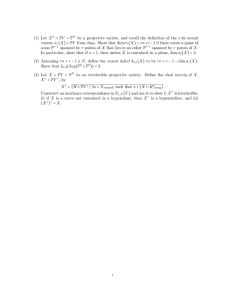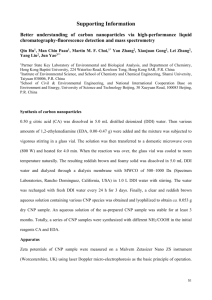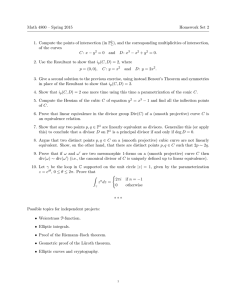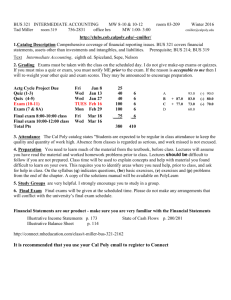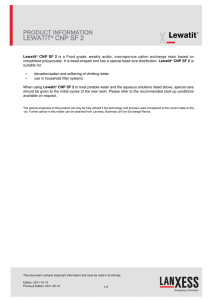Algebraic Curves/Fall 2015 Aaron Bertram .
advertisement
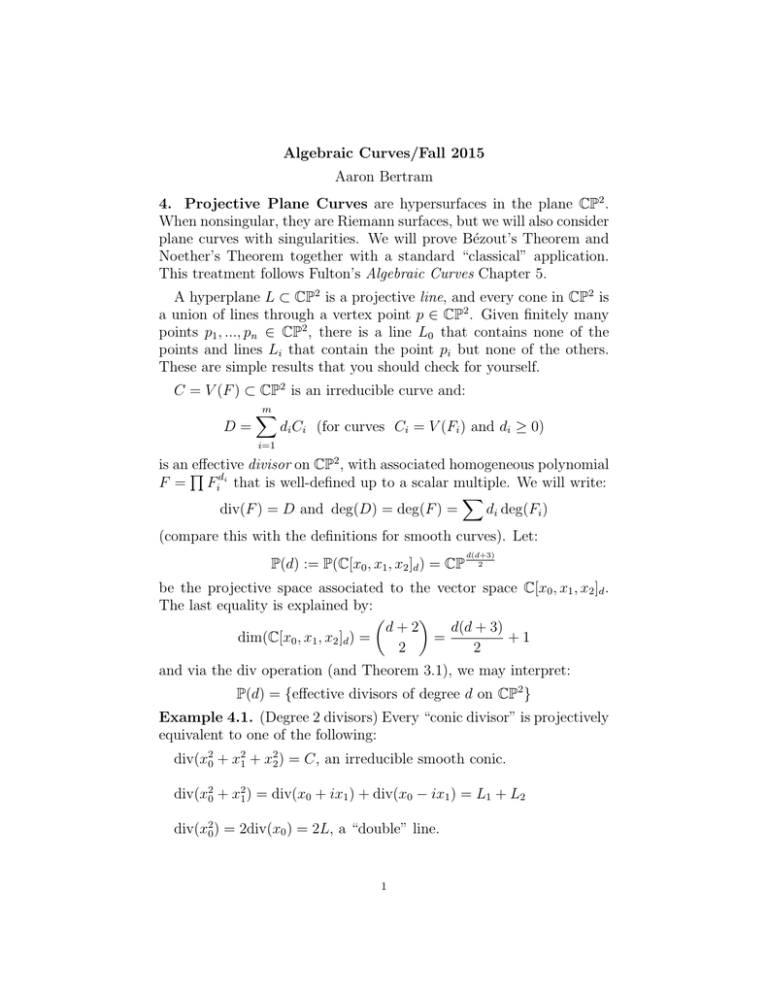
Algebraic Curves/Fall 2015
Aaron Bertram
4. Projective Plane Curves are hypersurfaces in the plane CP2 .
When nonsingular, they are Riemann surfaces, but we will also consider
plane curves with singularities. We will prove Bézout’s Theorem and
Noether’s Theorem together with a standard “classical” application.
This treatment follows Fulton’s Algebraic Curves Chapter 5.
A hyperplane L ⊂ CP2 is a projective line, and every cone in CP2 is
a union of lines through a vertex point p ∈ CP2 . Given finitely many
points p1 , ..., pn ∈ CP2 , there is a line L0 that contains none of the
points and lines Li that contain the point pi but none of the others.
These are simple results that you should check for yourself.
C = V (F ) ⊂ CP2 is an irreducible curve and:
m
X
D=
di Ci (for curves Ci = V (Fi ) and di ≥ 0)
i=1
is an Q
effective divisor on CP2 , with associated homogeneous polynomial
F = Fidi that is well-defined up to a scalar multiple. We will write:
X
div(F ) = D and deg(D) = deg(F ) =
di deg(Fi )
(compare this with the definitions for smooth curves). Let:
P(d) := P(C[x0 , x1 , x2 ]d ) = CP
d(d+3)
2
be the projective space associated to the vector space C[x0 , x1 , x2 ]d .
The last equality is explained by:
d+2
d(d + 3)
+1
dim(C[x0 , x1 , x2 ]d ) =
=
2
2
and via the div operation (and Theorem 3.1), we may interpret:
P(d) = {effective divisors of degree d on CP2 }
Example 4.1. (Degree 2 divisors) Every “conic divisor” is projectively
equivalent to one of the following:
div(x20 + x21 + x22 ) = C, an irreducible smooth conic.
div(x20 + x21 ) = div(x0 + ix1 ) + div(x0 − ix1 ) = L1 + L2
div(x20 ) = 2div(x0 ) = 2L, a “double” line.
1
2
Exercise 4.1. Every degree 3 divisor on CP2 is equivalent to one of:
(a) An elliptic curve Eλ = div(x0 x22 −x1 (x1 −x0 )(x1 −λx0 )), λ 6= 0, 1.
One of the following two singular irreducible curves:
(b) E0 = div(x0 x22 − x21 (x1 − x0 )) (the nodal cubic) or
(c) E∞ = div(x0 x22 − x31 ) (the cuspidal cubic)
(d) Or else a reducible divisor L + D where D is a conic divisor.
The multiplicity of an effective divisor D at p:
multp (D)
is the degree of the polynomial defining the tangent cone to D at p. In
projective coordinates chosen so that p0 = (1 : 0 : 0), multp0 (D) ≥ m
if and only if the associated polynomial of degree d:
X
F =
cI xi00 xi11 xi22
|I|=d
has the property that cI = 0 for all I = (i0 , i1 , i2 ) satisfying i0 > d − m.
Definition 4.1. Given a degree d > 0 and integers mi ≥ 0 at pi ∈ CP2 ,
P(d; m1 p1 , . . . , mr pr ) ⊂ P(d)
is the linear series of divisors D ∈ P(d) with each multpi (D) ≥ mi .
Remark. The linear series involving a single point P(d; mp) ⊂ P(d) are
projective linear subspaces of dimension:
d(d + 3) (m + 1)m
−
2
2
(or else empty) since as above, the linear series P(d; mp0 ) is defined by:
cI = 0 for I = (d, 0, 0), (d − 1, 1, 0), (d − 1, 0, 1), . . . , (d − m + 1, ∗, ∗)
and changing coordinates in the plane induces a (projective) linear
transformation on each of the projective spaces P(d), so the result
holds for an arbitrary point p ∈ CP2 .
Corollary 4.1. By definition:
P(d; m1 p1 , ...., mr pr ) = P(d; m1 p1 ) ∩ · · · ∩ P(d; mr pr )
and so the linear series is either a projective linear space satisfying:
r
d(d + 3) X (mi + 1)mi
dim(P(d; m1 p1 , ..., mn pn )) ≥
−
2
2
i=1
which is the “expected dimension” or else it is empty, which can only
occur when the expected dimension is negative.
3
Example 4.2. P(1) = CP2 is the (dual) projective plane of lines.
(a) dim(P(1; p)) = 1 and P(1; 2p) is empty.
(b) P(1; p, q) is the unique line through p and q.
(c) P(1; p, q, r) is empty unless the three points are collinear.
Thus the dimension of a linear series may depend upon the location
of the points. The problem of determining exact dimensions of linear
series for a particular configuration of points is very subtle in general.
Exercise 4.2. P(2) = CP5 is the projective space of conic divisors.
(a) Show that dim(P(2; p, q, r)) = 2 for all points p, q, r.
(b) Show that dim(P(2; p1 , ..., p5 )) = 0, i.e. there is a unique conic
through the five points unless four of the points are collinear.
(c) Show that P(2; 2p, 2q) is a single point for all pairs p and q.
Remark. (c) is interesting because the expected dimension is −1, and
yet for all pairs p, q ∈ CP2 , the linear series is not empty.
Proposition 4.1. Fix m1 , ..., mr ≥ 0. Then for all sufficiently large d,
r
d(d + 3) X (mi + 1)mi
dim(P(d; m1 p1 , ..., mr pr )) =
−
2
2
i=1
is as expected for all collections of (distinct) points p1 , ..., pr ∈ CP2 .
Proof. First consider the case mi = 1 for all i. It suffices to show:
P(d) ⊃ P(d; p1 ) ⊃ · · · ⊃ P(d; p1 , ..., pr )
are strict inclusions when d is large, since this forces the linear series
to drop in dimension with the introduction of each additional point.
Recall the lines L0 (containing none of the points) and Li (containing
one pi but none of the others) from the top of this section. Then:
(d − i)L0 + L1 + ... + Li ∈ P(d; p1 , ..., pi ) − P(d; p1 , ..., pi+1 )
exhibits the desired proper inclusions for each i = 1, ..., r − 1, provided
that d − i ≥ 0. Thus, d ≥ r − 1 is sufficiently large for this argument.
We reason similarly in the general case. We need to show:
P(d) ⊃ P(d; m1 p1 ) ⊃ · · · ⊃ P(d; m1 p1 , ..., mr pr )
each has the expected codimension in the one before.
This can be assured by finding projective linear subspaces
P(Vi ) ⊂ P(d; m1 p1 , ..., mi pi ) ⊂ P(d)
4
with the property that the intersection P(Vi ) ∩ P(d; mi+1 pi+1 ) ⊂ P(Vi )
has the expected codimension. We do this by letting:
P(Vi ) = {m1 L1 + ... + mi Li + D | D ∈ P(d − m1 − ... − mi )}
where Lj are the fixed lines. Then: P(Vi ) ∩ P(d; mi+1 pi+1 ) =
{m1 L1 + ... + mi Li + D | D ∈ P(d − m1 − ... − mi ; mi+1 pi+1 )}
reduces to the case of a single point linear series for divisors of degree
d−m
P1 − ... − mi , which has the expected codimension provided that
d − mj ≥ mi+1 − 1. For this argument, d ≥ m1 + ... + mr − 1 is
sufficiently large, and is, in fact, optimal for the result.
Next, we turn to Bézout’s Theorem, which is useful to think of as
a comparison between globally and locally defined data coming from
a pair of distinct irreducible plane curves C, C 0 ⊂ CP2 associated to
prime homogeneous polynomials A, A0 ∈ C[x0 , x1 , x2 ] of degrees a, a0 .
Global Data. The Hilbert function of the projective plane CP2 is:
d+2
2 for all d ≥ 0
hCP2 (d) = dim C[x0 , x1 , x2 ]d =
0 for all d < 0
which is a quadratic polynomial in d for all d ≥ 0.
The Hilbert function of the curve C is the eventually linear function:
d+2
− d+2−a
= ad + 1 − a−1
for all d ≥ a
2
2
2
d+2
hC (d) = dim(RC )d =
for all 0 ≤ d < a
2
0 for all d < 0
where RC = C[x0 , x1 , x2 ]/hAi is the homogeneous coordinate ring of C.
The Hilbert function of C ∩ C 0 is the eventually constant function:
hC (d) − hC (d − a0 ) = aa0 for all d ≥ a + a0
hC∩C 0 (d) = dim(RC∩C 0 )d =
other stuff for d < a + a0
where RC∩C 0 = C[x0 , x1 , x2 ]/hA, A0 i is the homogeneous coordinate ring
of the intersection C ∩ C 0 of the two curves.
Observation. The quotient ring RC is a graded integral domain, and
RC∩C 0 is graded, but usually not a domain. The notation is a little
misleading, since the set C ∩ C 0 is not enough information, in general,
to determine RC∩C 0 (the scheme structure on C ∩ C 0 is required).
5
In §5 we will prove that Hilbert functions are eventually polynomial
functions in much greater generality, and the degree will be one of the
ways of defining the dimension of a projective variety.
Remark. It follows already that the cardinality of the set C∩C 0 satisfies:
|C ∩ C 0 | ≤ aa0
hence in particular that C∩C 0 is finite. This is explained by Proposition
4.1, since each point p ∈ C ∩ C 0 supports a homogeneous polynomial
Fp ∈ P(d; C ∩ C 0 − p) − P(d; C ∩ C 0 ) that by definition vanishes at all
points of C ∩C 0 except p whenever d ≥ |C ∩D|−1. These are evidently
linearly independent vectors in (RC∩C 0 )d , which has dimension aa0 .
Local Data. With suitable coordinates, x0 does not divide A or A0
and the intersection C ∩ C 0 is contained in the set U0 = CP2 − V (x0 )
which may be identified with C2 with coordinates yi = xi /x0 . Let:
0
α(y1 , y2 ) = A/xa0 and α0 (y1 , y2 ) = A/xa0
and consider the “affine” coordinate rings:
C[y1 , y2 ]/hαi and C[y1 , y2 ]/hα, α0 i
associated to the affine curve and intersection of affine curves:
C aff = C ∩U0 = {(q1 , q2 ) ∈ C2 | α(q1 , q2 ) = 0} and C aff ∩(C 0 )aff = C ∩C 0
respectively. This “affine” data has the advantage that elements of the
affine coordinate rings are functions on C aff and C ∩ C 0 respectively.
We pass to local data via the fields of rational functions, which are
the same whether viewed projectively or affinely:
F
f
2
∼
K(CP ) =
| F, G ∈ C[x0 , x1 , x2 ]d =
| f, g ∈ C[y1 , y2 ] = K(C2 )
G
g
(with the usual equivalence relation on fractions) via the isomorphism:
F
F/xd0
f
f xn0
and 7→ n for sufficiently large n
7→
G
g
gx0
G/xd0
Notice in particular that α (but not A) is an element of K(CP2 ).
Definition 4.2. To each point p ∈ CP2 , define the ring:
F
OCP2 ,p =
| G(p) 6= 0 ⊂ K(CP2 )
G
of local functions defined at p, which has a unique maximal ideal:
mp = {φ ∈ OCP2 ,p | φ(p) = 0} ⊂ OCP2 ,p ⊂ K(CP2 )
of local functions vanishing at p.
6
Remark. These may alternatively be defined with affine coordinates:
mp ⊂ OC2 ,p = OCP2 ,p ⊂ K(C2 )
whenever p ∈ U0 = C2 , and in these coordinates it is clear that mp is
generated by two elements. For example, when p = (1 : 0 : 0) ∈ CP2 ,
then p = (0, 0) ∈ C2 , and mp is generated by the coordinates y1 , y2 .
Similarly, we may define the fields of rational functions on C:
F
f
∼
K(C) =
| F, G ∈ (RC )d =
| f, g ∈ C[y1 , y2 ]/hαi = K(C aff )
G
g
with local ring and maximal ideal for all p ∈ C given by:
F
mp = {φ | φ(p) = 0} ⊂ OC,p =
| G(p) 6= 0 ⊂ K(C)
G
and if p ∈ C aff , then OC,p = OC aff ,p .
Remark. The coordinate ring RC (or C[y1 , y2 ]/hαi) of a plane curve C
does not usually have unique factorization, in which case there is no
natural “lowest terms” fraction representing a typical φ ∈ K(C).
Exercise 4.3. (a) Regarding α ∈ mp ⊂ OCP2 ,p for p ∈ C, show that:
OCP2 ,p /hαi ∼
= OC,p
(b∗ ) Suppose I = hf1 , ..., fn i ⊂ C[y1 , y2 ] is an ideal such that the set:
V (I) = {p ∈ C2 | fi (p) = 0 ∀fi } ⊂ C2
is finite. Show that the natural map:
C[y0 , y1 ]/I 7→ ×p∈V (I) OCP2 ,p /hf1 , ..., fn i; f 7→ (f, ..., f )
is an isomorphism onto the product of local rings.
Remark. Exercise 4.3 (b) is starred because it is both challenging and
extremely important. The local rings should be thought of as “germs”
of functions, and the Exercise shows that an arbitrary choice of germs
can be pieced together to come from a single polynomial (mod I). This
isn’t even obvious when V (I) is a single point!
Proposition 4.2. (a) If p ∈ C is a non-singular point, then mp ⊂ OC,p
is a principal ideal, i.e. OC,p is a discrete valuation ring.
(b) For any p ∈ C, the dimensions of the quotient vector spaces:
dimC mnp /mn+1
p
are constant for large n, equal to the multiplicity of C ⊂ CP2 at p ∈ C.
In particular, if p ∈ C is a singular point, then OC,p is not a DVR.
7
Proof. For (a), we may choose coordinates that p = (1 : 0 : 0) and
the Zariski tangent line to C at p is x1 = 0, so that:
α(y1 , y2 ) = y1 f + y22 g ∈ C[y1 , y2 ]; with f (0, 0) 6= 0
Since y1 , y2 generate mp ⊂ OCP2 ,p and y1 f = α − y22 g and f is a unit
in OCP2 ,p , it follows from Exercise 4.3 (a) that y 1 ∈ hy 2 i ⊂ OC,p and
y 1 , y 2 generate mp ⊂ OC,p , so y 2 by itself is a generator of mp ⊂ OC,p .
(b) From the isomorphism:
/ OC,p /mnp
= OC,p /mn+1
mnp /mn+1
p
p
it suffices to prove that dimC OC,p /mnp is eventually linear, of the form
multp (C)d + constant. Choose coordinates so that p = (1 : 0 : 0) and
let I = hy0 , y1 i ⊂ C[y0 , y1 ]. Then the natural map:
C[y1 , y2 ]/hα, I n i → OC,p /mnp = OCP2 ,p /hα, I n i
is an isomorphism by Exercise 4.3 (a) and (b). Let m = multp (C).
Then multiplication by α maps I n−m into I n , and:
·α
0 → C[y0 , y1 ]/I n−m → C[y0 , y1 ]/I n → C[y0 , yn ]/hα, I n i → 0
is an exact sequence of C[y0 , y1 ]-modules, hence:
dimC OC,p /mnp = dimC C[y0 , y1 ]/I n − C[y0 , y1 ]/I n−m
for all n ≥ m, and it is a quick check to see that:
n+1
dimC C[y0 , y1 ]/I = 1 + 2 + ... + n =
2
n
from which it follows that for all n ≥ m,
n+1
n+1−m
m
n
dimC OC,p /mp =
−
= mn −
2
2
2
as desired.
Remark. This is a second occurrence of a Hilbert function. Here it is
attached to the local ring OC,p as the (eventually) linear function:
∞
M
dimC OC,p /mnp
n=0
Let us return now to our two distinct, irreducible plane curves
C ∩ C 0 = C aff ∩ (C 0 )aff
Definition 4.3. The intersection number at p ∈ C ∩ C 0 is:
Ip (C ∩ C 0 ) := dimC OCP2 ,p /hα, α0 i
8
Bézout’s Theorem 4.1. The globally defined “Hilbert polynomial”
aa0 of the graded ring R = C[x0 , x1 , x2 ]/hA, A0 i is the sum of locally
defined intersection numbers:
X
aa0 =
Ip (C ∩ C 0 )
p∈C∩C 0
Proof. In our coordinates so that the line x0 = 0 does not contain
any of the (finitely many!) intersection points of C and C 0 ,
X
Ip (C ∩ C 0 ) = dimC C[y1 , y2 ]/hα, α0 i
p
by Exercise 4.3 (b) with α, α0 defined as earlier, so the proof amounts
to showing that the maps Rd → C[y1 , y2 ]/hα, α0 i; F 7→ f = F/xd0 are
isomorphisms for sufficiently large d.
First we show that the multiplication maps
µx0 : Rd → Rd+1 ; µx0 (F ) = F x0
are injective for all d and therefore isomorphisms for all d ≥ a + b.
To see this, suppose x0 H = F A + F 0 A0 for some F, F 0 . Then:
0 = F0 A0 + F00 A00 ∈ C[x1 , x2 ] = C[x0 , x1 , x2 ]/hx0 i
where F0 = F (0, x1 , x2 ), etc. But A0 , A00 ∈ C[x1 , x2 ] are relatively
prime (because C ∩ C 0 ∩ V (x0 ) = V (A0 ) ∩ V (A00 ) = ∅), so F00 = EA0
and F0 = −EA00 for some E ∈ C[x1 , x2 ]. Let:
G = F + EA0 and G0 = F 0 − EA
Then x0 H = GA + G0 A0 and both G and G0 are divisible by x0 , by
construction, so H = (G/x0 )A + (G0 /x0 )A0 , proving injectivity.
Now fix d ≥ a + a0 and F1 , ..., Faa0 ∈ C[x0 , x1 , x2 ]d whose images in
Rd are a basis. Let fi = Fi /xd0 , as usual. Then we need to show:
(∗) The images of f1 , ..., faa0 ∈ C[y1 , y2 ] in C[y1 , y2 ]/hα, α0 i are a basis
P
Suppose
λi fi = gα + hα0 ∈ C[y1 , y2 ] for
λi ∈ C. Multiplying
P some
r
by a sufficiently large power of x0 gives
λi x0 Fi = xs0 GA + xt0 HA0
for
r, s, t and homogeneous
polynomials G, H, which shows that
P some
P
r
λi x0 Fi = 0 in Rd+r and
λi Fi = 0 in Rd by the injectivity of µx0 .
So the fi are linearly independent.
Suppose P
γ ∈ C[y1 , y2 ] and let Γ = xn0 γ ∈ C[x0 , x1 , x2 ]n for n = d + r.
Then Γ =
λiP
xr0 Fi + GA + HA0 since theP
xr0 Fi are a basis for Rd+r ,
and then γ =
λi fi + gα + hα0 , so γ =
λi fi in C[y1 , y2 ]/hα, α0 i.
This proves surjectivity, and completes the proof of (*) and therefore
of Bézout’s Theorem.
9
Bézout’s theorem begs the following:
Question. How do we compute the intersection numbers:
Ip (C ∩ C 0 ) = dimC OCP2 ,p /hα, α0 i?
This is answered in many cases by:
Proposition 4.3. (a) Suppose p ∈ C is a non-singular point. Then:
Ip (C ∩ C 0 ) is the order of vanishing of the element α0 in the DVR OC,p
(b) Suppose p ∈ C ∩ C 0 is an arbitrary intersection point. Then:
Ip (C ∩ C 0 ) ≥ multp (C) · multp (C 0 )
with equality if and only if the tangent cones to C and C 0 at p are
“transverse,” i.e. they do not share a common line.
Proof. (a) is straightforward. OCP2 ,p /hα, α0 i = (OCP2 ,p /hαi) /hα0 i =
OC,p /hα0 i by Exercise 4.3 (a), and the dimension of OC,p /hα0 i is the
order of α0 (the value of d so that hα0 i = mdp ) in the DVR OC,p .
For (b), assume as usual that p = (1 : 0 : 0) and let m = multp (C)
and m0 = multp (C 0 ) and consider the surjective map:
0
0
q : OCP2 ,p /hα, α0 i → OCP2 ,p /hα, α0 , mm+m
i = C[y1 , y2 ]/hα, α0 , I m+m i
p
0
where I m+m is the ideal generated by monomials of degree m + m0 in
y1 , y2 . (The last equality, as usual, comes from Exercise 4.3 (b).)
There is an exact sequence:
0
k
0
0
C[y1 , y2 ]/I m ⊕C[y1 , y2 ]/I m → C[y1 , y2 ]/I m+m → C[y1 , y2 ]/hα, α0 , I m+m i → 0
where k(f, g) = f α0 − gα, from which we conclude the first part of (b):
0
Ip (C ∩ C 0 ) = dimC OCP2 ,p /hα, α0 i ≥ dim C[y1 , y2 ]/hα, α0 , I m+m i
0
m + m0 + 1
m+1
m +1
≥
−
−
= mm0
2
2
2
with equality if and only if q, k are both injective. We finish the proof
with two observations about q and k.
(i) k is injective if and only if C, C 0 do not share a tangent line at p.
Suppose, on the contrary, that their tangent cones at (0, 0) ∈ C2
share a common tangent line l = 0. Then the Taylor expansions are:
0
0
0
α = lαm−1 + αm+1 + ... + αa and α0 = lαm
0 −1 + αm0 +1 + · + αa0
0
0
0
0
m+m
and k(αm−1 , αm
exhibits a non-zero
0 −1 ) = αm−1 α − αm0 −1 α ∈ I
element of the kernel of k.
10
Conversely, if (f, g) ∈ ker(k) and f = fd + ... and g = ge + ..., then
fd αm0 − ge αm = 0 and d < m, e < m0 imply that the polynomials
0
αm
0 , αm defining the tangent cones share a common factor.
(ii) If C, C 0 do not share a common tangent, then q is injective.
First, notice that because Ip (C ∩ C 0 ) = dimC OCP2 ,p /hα, α0 i is finite,
it follows that the map:
0 N
qN : OCP2 ,p hα, α0 i → OCP2 ,p /hα, α0 , mN
p i = C[y1 , y2 ]/hα, α , I i
is injective for sufficiently large values of N . Thus, it suffices to show:
0
C[y1 , y2 ]/hα, α0 , I N i → C[y1 , y2 ]/hα, α0 , I m+m i
is injective for all N ≥ m + m0 . But this follows from:
0
Exercise 4.4. If αm , αm
0 ∈ C[y0 , y1 ] are homogeneous forms of degrees
0
m, m > 0 with no common factors, then:
0
C[y0 , y1 ]m0 −1 · αm + C[y0 , y1 ]m−1 · αm
0 = C[y0 , y1 ]m+m0 −1
As an example of how to use the Proposition, consider:
Exercise 4.5. Find the intersection points of the singular cubic curves:
E0 ∩ E∞ (from Exercise 4.1),
compute each multiplicity Ip (E0 ∩ E∞ ) and check that they sum to 9.
Bézout’s Theorem extends as stated to divisors:
Bézout’s Theorem (Divisor Version) Let D ∈ P(d), D0 ∈ P(d0 ) be
effective divisors with associated homogeneous polynomials F and F 0 .
Then either the supports |D| and |D0 | share an irreducible curve or else
their intersection is finite, and:
X
dd0 =
dimC OCP2 ,p /hf, f 0 i
p∈|D|∩|D0 |
where f = F/xdi , f 0 = F 0 /xdi for any coordinate xi not vanishing at p.
Moreover,
dd0 = dimC Rn = dimC (C[x0 , x1 , x2 ]/hF, F 0 i)n for n ≥ d + d0
the multiplication maps µxi : Rn → Rn+1 are all injective and all of the
maps Rn → C[y1 , y2 ]/hf, f 0 i → ×OCP2 ,p /hf, f 0 i are isomorphisms when
n ≥ d+d0 as in the proof of Theorem 4.1 (provided |D|∩|D0 | ⊂ Ui = C2 )
P
Remark. The support of a divisor D = di Ci is the union:
[
|D| =
Ci
i|di 6=0
of the irreducible curves appearing with nonzero coefficient in D.
11
Proof. The equality of numbers follows from Theorem 4.1 and:
dimC OCP2 ,p /hf, ghi = dimC OCP2 ,p /hf, gi + dimC OCP2 ,p /hf, hi
The rest is proved simply by replacing prime polynomials A and A0
with relatively prime polynomials F and F 0 in all the earlier proofs. P
P 0 0
Let D = di Ci and D0 =
dj Cj .
Corollary 4.2. Suppose |D|∩|D0 | consists of dd0 distinct points. Then
every intersection point is a non-singular point of both D and D0 , i.e.
(a) Every intersection point belongs to a unique pair Ci and Cj0 .
(b) Each intersection is a nonsingular point of Ci and Cj0 .
(c) Each of the local intersection rings at p ∈ Ci ∩ Cj satisfies:
hf, f 0 i = mp ⊂ OCP2
(i.e. the intersections of Ci and Cj0 are transverse).
(d) Each di = d0j = 1 for all i, j (because each Ci and Cj0 intersects!)
Proof. If any of these conditions were violated, then there would be
an intersection point with intersection number > 1.
Noether’s Theorem. Let F, F 0 ∈ C[x0 , x1 , x2 ] be homogeneous and
relatively prime and suppose G ∈ C[x0 , x1 , x2 ]d maps to zero under:
Rd → C[y1 , y2 ]/hf, f 0 i ∼
= ×p∈V (F )∩V (F 0 ) OCP2 ,p /hf, f 0 i
Then G = HF + H 0 F 0 for homogeneous polynomials H, H 0 .
Proof. If d ≥ n =≥ deg(F )+deg(F 0 ), then the map in question is an
isomorphism, and we are done by definition. Otherwise, by injectivity
of the maps µxi , we see that xin−d H = 0 ∈ Rn , so H = 0 in Rd .
Corollary 4.3. Suppose D and D0 intersect in dd0 points, and D00
passes through all of them. Then the associated polynomials satisfy:
F 00 = HF + H 0 F 0 for some homogeneous H, H 0
Proof. Using Corollary 4.2(c), Noether’s Theorem applies!
As an application, we study the following:
Proposition 4.4. Let D, D0 be cubic divisors on CP2 intersecting in
9 distinct points p1 , ..., p9 . Then:
(a) dim P(3; p1 , ..., p9 ) = 1
(b) P(3; p1 , ...., p8 ) = P(3; p1 , ...., p9 ).
Recall that the expected dimension of P(3; p1 , ..., pn ) = 9 − n, so (b)
says that p1 , ..., p8 “impose independent conditions” on cubic divisors.
12
Proof. (a) is immediate from the Corollary. If D00 ∈ P(3; p1 , ..., p9 ),
then the associated cubic polynomial F 00 vanishes at all the points,
and F 00 = aF + a0 F 0 for constants a and b. Thus P(3; p1 , ..., p9 ) = P(V )
where V is the two-dimensional vector space with basis F and F 0 .
For (b), suppose D00 ∈ P(3; p1 , ..., p8 ) − P(3; p1 , ..., p9 ). Let q be the
ninth point of the intersection D00 ∩ D (possibly coming from a point
with intersection number 2). If q 6= p9 , let L be a line through p9 but
not q, and let L ∩ D = p9 + r + s with r, s 6∈ |D0 |. Then:
lF 00 = l1 F + l2 F 0
by the Corollary for the associated cubic polynomials F, F 0 , F 00 and
linear forms l (defining L) and some forms L1 , L2 since L + D00 contains
all the points p1 , ..., p9 = D ∩ D0 . Evaluating at the points, we see
that l2 (r) = l2 (s) = 0, so l2 = l = l1 (up to scalar multiples), and
F 00 = aF + a0 F 0 , which is a contradiction!
Example 4.3. (Pascal’s Mystic Hexagon) If a hexagon is inscribed in
an irreducible conic, then the three sets of opposite sides meet in three
collinear points.
Proof. Let C be the conic, L1 , L2 , L3 be one set of opposite sides
and M1 , M2 , M3 the other. Then:
(L1 + L2 + L3 ) ∩ (M1 + M2 + M3 ) = p1 + ... + p6 + q1 + q2 + q3
where p1 , ..., p6 are the vertices of the hexagon and q1 , q2 , q3 are the
other points. But a third cubic divisor
(L1 + L2 + L3 ) ∩ (C + q1 q2 )
contains p1 , ..., p6 , q1 , q2 , so it contains q3 as well, and q3 6∈ C, so it must
be on the line q1 q2 .
Exercise 4.6. (a) Let E ⊂ CP2 be a nonsingular cubic curve, choose
an arbitrary point 0 ∈ E. If L is a line in CP2 , define:
X
L · E = p1 + p2 + p3 :=
Ip (L, E)p
as a divisor on E and the sum p1 ⊕ p2 of points p1 , p2 ∈ E by:
(i) φ(p1 , p2 ) = p3 if L · E = p1 + p2 + p3 and:
(ii) p1 ⊕ p2 = φ(0, φ(p1 , p2 )).
This is evidently commutative. Show that it is associative with 0 as
an additive identity and that it agrees with the addition on the curves
EΛ coming from a lattice Λ ⊂ C from §2.
